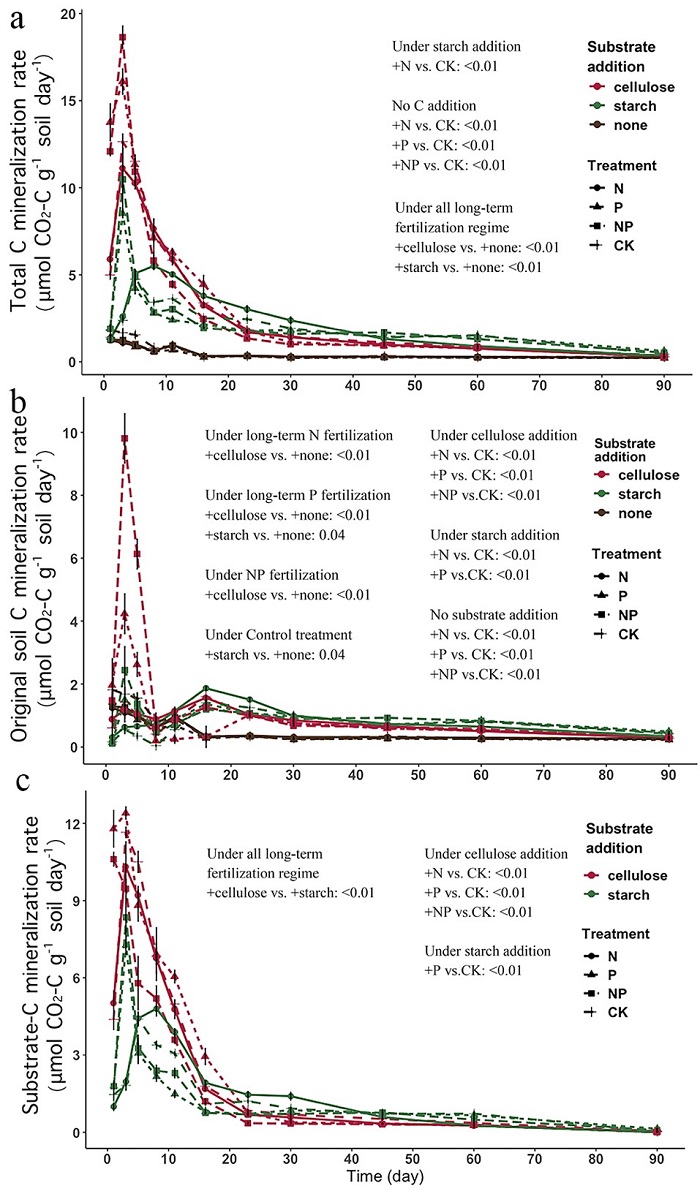

Soil organic carbon (SOC) turnover is strongly influenced by substrate and nutrient availability, especially nitrogen (N) and phosphorus (P). Although many short-term N and P addition experiments have investigated the relationship between nutrient availability and soil organic matter (SOM) mineralization, few studies have explored SOM mineralization using long-term fertilized soil. Long-term fertilization will change the soil biochemical properties, therefore, the changes of SOM mineralization under short-term or single nutrient input cannot well reflect the effects of long-term fertilization or nutrients addition.
Under the guidance of Professor Faming Wang, Jingfan Zhang, a master student of Xiaoliang Research Station of South China Botanical Garden, CAS, conducted a 90-day incubation experiment using a tropical coastal site with 11 years of N and P fertilization history. Two substrates were added to soils: corn starch or corn cellulose. Total soil C mineralization rate (CO2 flux) was measured to characterize SOM mineralization, and 13C isotope techniques were used to determine the source of CO2 (soil original carbon or substrate carbon). Extracellular enzymes and soil microbial community compositions were determined to explain differences of SOM mineralization rate under different fertilization treatments and substrate additions.
The research found that, with the substrate addition, the SOM mineralization rate increased significantly under N and P fertilization, while in soils without substrate addition, N and P inhibited the original soil C mineralization rate. The addition of both substrates can enhance enzyme activities, but the P fertilization decreased it. The addition of both substrates increased microbial investment in P, while only the addition of starch promoted microbial investment in N. Finally, with substrate addition, fungal abundance increased more than bacterial abundance, especially in the soil with cellulose addition, and long-term fertilization had a greater impact on fungal abundance. The results suggest that the SOM mineralization may be enhanced in an ecosystem with high availability of N and P, because the input of litter can relieve microbial carbon constraints and promote SOM mineralization when N and P are sufficient. Our study further shows that the effects of structurally similar substrates on SOM mineralization are also significantly different, and the degree of SOM mineralization strongly depends on elemental stoichiometry, as well as the resource requirements of microbial decomposers.
This research article was published online in “Science of the Total Environment”, titled “Long-term fertilization modifies the mineralization of soil organic matter in response to added substrate”, for detailed information, please see https://doi.org/10.1016/j.scitotenv.2021.149341

Figure 1. Carbon (C) mineralization rates in soils from long-term fertilization treatments during
a 90-day incubation experiment with substrate additions, showing (a) total C mineralization,
(b) soil organic matter (SOM) mineralization and (c) substrate-C mineralization.

Graphic abstracts. Schematic representation of the microbial mechanisms of carbon
(C) mineralization in soils from long-term fertilization experiments in a secondary tropical forest of south China amended with cellulose or starch during a 90-day incubation,
showing (a) total C mineralization, (b) original soil C mineralization and (c) substrate-C mineralization.

